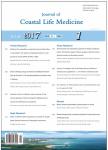Diet and feeding ecology of black-barred halfbeak Hemiramphus far(Forsskal, 1775) (Hemiramphidae) from Karachi coast of Pakistan
Diet and feeding ecology of black-barred halfbeak Hemiramphus far(Forsskal, 1775) (Hemiramphidae) from Karachi coast of Pakistan作者机构:Department of ZoologyFederal Urdu University of ArtsScience and TechnologyGulshan-e-Iqbal CampusKarachi75300Pakistan Department of ZoologyUniversity of KarachiKarachi75270Pakistan Department of FisheriesFaculty of AgricultureUniversity of RajshahiRajshahi6205Bangladesh
出 版 物:《Journal of Coastal Life Medicine》 (海岸生命医学杂志(英文版))
年 卷 期:2017年第5卷第1期
页 面:4-6页
学科分类:1002[医学-临床医学] 100214[医学-肿瘤学] 10[医学]
主 题:Pakistan Karachi coast Feeding ecology Stomach contents Hemiramphus far
摘 要:Objective:To describe the diet and feeding ecology ofHemiramphus far (H. far) through investigating the stomach contents. Methods: Sampling of total 430 individuals ofH. far was carried out from commercial catches landed at West Wharf fish harbor of Karachi coast, Pakistan during January–December 2010. The total length and weight of each individual were recorded. Samples were parted into Group 1 (15–20 cm,n = 240) and Group 2 (21–26 cm,n = 190), to estimate changes in diet with fish size. To remove alimentary canal, fishes were dissected and kept into 10% formalin. Then gut contents were examined under a light microscope for each intestine. Stomach fullness as well as dietary composition was ascertained from gut contents. Examination and analyses were conducted using frequency of occurrence and numerical method. Results:The examination confirmed 47.67% stomach as empty. Furthermore, our study revealed that the diet ofH. far consists of fishes, isopods, ostracods,Daphnia, shells, algae, unidentified plants and animal materials. This study proved thatH. far is an omnivorous fish feeding on fishes, isopods, shells, algae and plant and animal originated different food items. According to the Schoener overlap index, there was no significant difference in feeding of the two length groups ofH. far (C = 0.833). In addition, the Shannon-Wiener index presented that in Group 1, the prey diversity of the halfbeak was lower (H = 0.90) than that of Group 2 (H = 1.02). Conclusions: The findings of the present study would be very effective for sustainable management of black-barred halfbeak fishery in the Karachi coast of Pakistan and the surrounding ecosystems.



